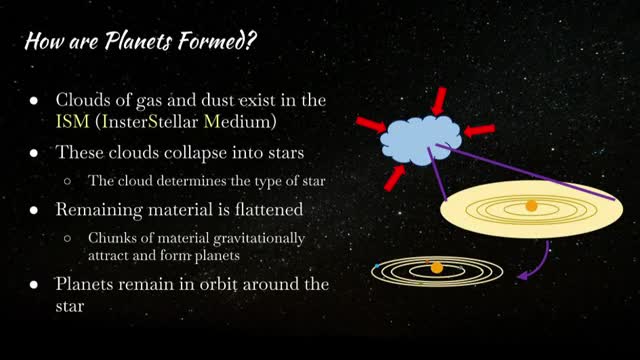NASA's James Webb Telescope reveals secrets of star and planet formation in distant systems
This article was created by AI summarizing key points discussed. AI makes mistakes, so for full details and context, please refer to the video of the full meeting. Please report any errors so we can fix them. Report an error »

In the cozy atmosphere of the Newton Free Library, a gathering of astronomy enthusiasts leaned in, captivated by the intricate dance of celestial bodies. The evening's focus was on the formation of stars and planets, a topic that sparked curiosity and wonder among attendees eager to understand the cosmos.
The discussion began with the fundamental building blocks of the universe: gas, dust, and molecules that exist in the vastness of space. As the speaker explained, these elements often find themselves in a gravitational tug-of-war, leading to a collapse that can occur due to various factors, including the collision of black holes. This dramatic event sends ripples through the surrounding clouds, initiating a process that ultimately leads to the birth of stars.
As the audience listened intently, they learned how this stellar formation is not instantaneous but rather a slow, intricate process that unfolds over millions, even billions, of years. The speaker illustrated how a spherical cloud of material begins to spin and flatten, resembling a pancake, as it gathers momentum. This motion is crucial, as it sets the stage for the formation of planets, which emerge from the leftover material orbiting the newly formed star.
Questions from the audience revealed a thirst for knowledge about the universe's complexities. One participant inquired about the differences between various planetary systems, prompting a discussion about observational biases in astronomy. The speaker noted that many systems are observed from a flat perspective, which can skew our understanding of their true nature.
The conversation shifted to the tools of modern astronomy, highlighting the role of advanced telescopes like the James Webb Space Telescope. This remarkable instrument, positioned a million miles from Earth, provides astronomers with unprecedented views of distant protoplanetary disks—regions where new planets are forming around stars.
As the evening progressed, the speaker delved into the specifics of our solar system, comparing the sizes and characteristics of planets. Attendees learned about the unique conditions that allowed gas giants like Jupiter to form, while icy planets remained smaller due to their distance from the sun and the effects of solar wind.
The session concluded with a sense of wonder and curiosity, as participants left with a deeper understanding of the cosmic processes that shape our universe. The Newton Free Library's Astronomy Night for Adults not only illuminated the mysteries of space but also fostered a community of inquisitive minds eager to explore the stars.
The discussion began with the fundamental building blocks of the universe: gas, dust, and molecules that exist in the vastness of space. As the speaker explained, these elements often find themselves in a gravitational tug-of-war, leading to a collapse that can occur due to various factors, including the collision of black holes. This dramatic event sends ripples through the surrounding clouds, initiating a process that ultimately leads to the birth of stars.
As the audience listened intently, they learned how this stellar formation is not instantaneous but rather a slow, intricate process that unfolds over millions, even billions, of years. The speaker illustrated how a spherical cloud of material begins to spin and flatten, resembling a pancake, as it gathers momentum. This motion is crucial, as it sets the stage for the formation of planets, which emerge from the leftover material orbiting the newly formed star.
Questions from the audience revealed a thirst for knowledge about the universe's complexities. One participant inquired about the differences between various planetary systems, prompting a discussion about observational biases in astronomy. The speaker noted that many systems are observed from a flat perspective, which can skew our understanding of their true nature.
The conversation shifted to the tools of modern astronomy, highlighting the role of advanced telescopes like the James Webb Space Telescope. This remarkable instrument, positioned a million miles from Earth, provides astronomers with unprecedented views of distant protoplanetary disks—regions where new planets are forming around stars.
As the evening progressed, the speaker delved into the specifics of our solar system, comparing the sizes and characteristics of planets. Attendees learned about the unique conditions that allowed gas giants like Jupiter to form, while icy planets remained smaller due to their distance from the sun and the effects of solar wind.
The session concluded with a sense of wonder and curiosity, as participants left with a deeper understanding of the cosmic processes that shape our universe. The Newton Free Library's Astronomy Night for Adults not only illuminated the mysteries of space but also fostered a community of inquisitive minds eager to explore the stars.
View full meeting
This article is based on a recent meeting—watch the full video and explore the complete transcript for deeper insights into the discussion.
View full meeting